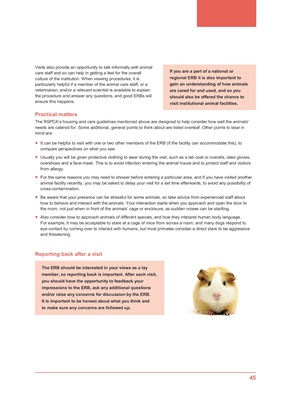
45
Visits also provide an opportunity to talk informally with animal
care staff and so can help in getting a feel for the overall
culture of the institution. When viewing procedures, it is
particularly helpful if a member of the animal care staff, or a
veterinarian, and/or a relevant scientist is available to explain
the procedure and answer any questions, and good ERBs will
ensure this happens.
Practical matters
The RSPCA"s housing and care guidelines mentioned above are designed to help consider how well the animals'
needs are catered for. Some additional, general points to think about are listed overleaf. Other points to bear in
mind are:
It can be helpful to visit with one or two other members of the ERB (if the facility can accommodate this), to
compare perspectives on what you see.
Usually you will be given protective clothing to wear during the visit, such as a lab coat or overalls, latex gloves,
overshoes and a face-mask. This is to avoid infection entering the animal house and to protect staff and visitors
from allergy.
For the same reasons you may need to shower before entering a particular area, and if you have visited another
animal facility recently, you may be asked to delay your visit for a set time afterwards, to avoid any possibility of
cross-contamination.
Be aware that your presence can be stressful for some animals, so take advice from experienced staff about
how to behave and interact with the animals. Your interaction starts when you approach and open the door to
the room, not just when in front of the animals" cage or enclosure, as sudden noises can be startling.
Also consider how to approach animals of different species, and how they interpret human body language.
For example, it may be acceptable to stare at a cage of mice from across a room, and many dogs respond to
eye contact by coming over to interact with humans, but most primates consider a direct stare to be aggressive
and threatening.
Reporting back after a visit
If you are a part of a national or
regional ERB it is also important to
gain an understanding of how animals
are cared for and used, and so you
should also be offered the chance to
visit institutional animal facilities.
The ERB should be interested in your views as a lay
member, so reporting back is important. After each visit,
you should have the opportunity to feedback your
impressions to the ERB, ask any additional questions
and/or raise any concerns for discussion by the ERB.
It is important to be honest about what you think and
to make sure any concerns are followed up.